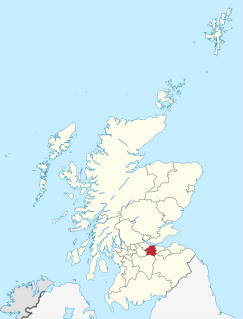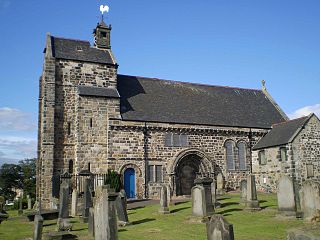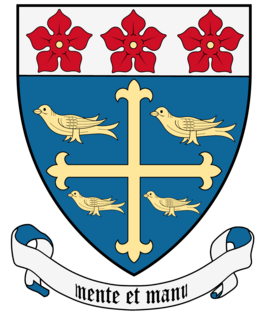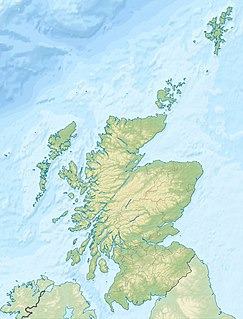
West Lothian is one of the 32 council areas of Scotland, and one of its historic counties. The county, which was also known as Linlithgowshire, was bounded by the Avon to the west and the Almond to the east. The modern council area occupies a smaller area, with areas in the west transferred to Falkirk and areas in the east transferred to Edinburgh following local government reforms in the late 20th century. It did however gain areas from Midlothian.

The Firth of Forth is the estuary (firth) of several Scottish rivers including the River Forth. It meets the North Sea with Fife on the north coast and Lothian on the south. It was known as Bodotria in Roman times. In the Norse sagas it was known as the Myrkvifiörd. An early Welsh name is Merin Iodeo, or the "Sea of Iudeu".

The Forth Road Bridge is a suspension bridge in east central Scotland. The bridge opened in 1964 and at the time was the largest suspension bridge in the world outside the USA. The bridge spans the Firth of Forth, connecting Edinburgh, at Queensferry, to Fife, at North Queensferry. It replaced a centuries-old ferry service to carry vehicular traffic, cyclists and pedestrians across the Forth; railway crossings are made by the nearby Forth Bridge, opened in 1890.

Queensferry is a small town, community and electoral ward in Flintshire, Wales, lying on the River Dee near the border with England. The community includes the village of Sandycroft.

Edinburgh West was a constituency of the Scottish Parliament (Holyrood) from 1999 until 2011. It elected one Member of the Scottish Parliament (MSP) by the plurality method of election. It was also one of nine constituencies in the Lothians electoral region, which elected seven additional members, in addition to nine constituency MSPs, to produce a form of proportional representation for the region as a whole.

Kirkliston is a small town and parish to the west of Edinburgh, Scotland, historically within the county of West Lothian. It lies on high ground immediately north of a northward loop of the Almond, on the old road between Edinburgh and Linlithgow, having a crossroads with the road from Newbridge to Queensferry and beyond to Fife. The B800 is variously named Path Brae, High Street, Station Road, and Queensferry Road as it passes through the town. The B9080 is named Main Street and Stirling Road as it passes through.

Craigleith is an area of west Edinburgh, Scotland. Its name comes from various forms of Craig of Inverleith, or rock or hill of Inverleith. Much of the Craigleith sandstone was used to build the old and new town houses in Edinburgh as well as many famous buildings including Edinburgh Castle, Holyrood Palace and the statue of Nelson on Nelson's Column in London. Because of its particular hardness, Craigleith Sandstone was also favoured for cutting stones used in the making of cut glass during the Victorian era.

The Fife Coastal Path is a Scottish long distance footpath that runs from Kincardine to Newburgh along the coastline of Fife. The path was created in 2002, originally running from North Queensferry to Tayport. It was extended in 2011 with a new section running from Kincardine to North Queensferry, then again in 2012 from Newburgh to Tayport. The path, which usually takes between one week and 10 days to walk in full, now runs for 187 kilometres (116 mi). The Fife Coastal Path is managed and maintained by Fife Coast and Countryside Trust, a registered environmental charity, and is designated as one of Scotland's Great Trails by Scottish Natural Heritage. About 500,000 people use the path every year, of whom about 35,000 walk the entire route.

Port Edgar is a marina on the southern shore of the Firth of Forth, immediately west of the Forth Road Bridge and the town of South Queensferry, in West Lothian. Originally a naval base, HMS Lochinvar, Port Edgar is now a busy marina with a sailing school and 300 berths. The Edgar commemorated in the name is Edgar Aetheling, the brother of Queen Margaret.

Queensferry High School is a six-year comprehensive school in the town of South Queensferry, Scotland, run by the City of Edinburgh Council. It was opened in 1970 by Princess Margaret marking the 900th anniversary of the arrival of Queen Margaret in Queensferry. Currently it has 761 students, predominantly from Echline Primary School, Queensferry Primary School, Dalmeny Primary School and Kirkliston Primary School. It was made a School of Ambition in 2007.

The Forth Bridge is a cantilever railway bridge across the Firth of Forth in the east of Scotland, 9 miles west of Edinburgh City Centre. It is considered as a symbol of Scotland, and is a UNESCO World Heritage Site. It was designed by the English engineers Sir John Fowler and Sir Benjamin Baker. It is sometimes referred to as the Forth Rail Bridge, although this has never been its official name.
Bellstane Birds Football Club was a Scottish association football club based in Queensferry, West Lothian. The club was founded in 1882 and disbanded in 1891. The club competed in the Scottish Cup for five seasons between 1886 and 1891. The club's home colours were red and blue.
Dunfermline in Fife was a royal burgh that returned one commissioner to the Parliament of Scotland and to the Convention of Estates.
Inverkeithing in Fife was a royal burgh that returned one commissioner to the Parliament of Scotland and to the Convention of Estates.
The Dunfermline and Queensferry Railway was a railway company founded to form part of a rail and ferry route between Dunfermline and Edinburgh, in Scotland. It was authorised in 1873 and its promoters had obtained informal promises from the larger North British Railway that the NBR would provide financial help, and also operate the ferry and the necessary railway on the southern side of the Firth of Forth.
Events from the year 2017 in Scotland.













